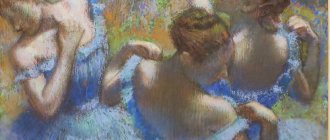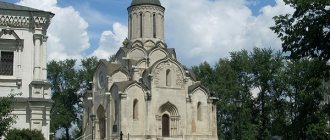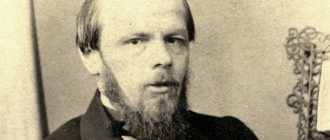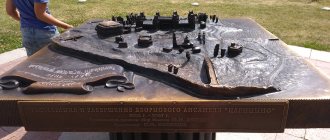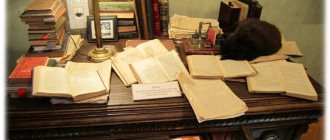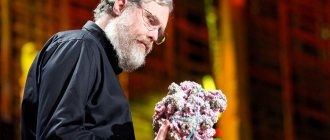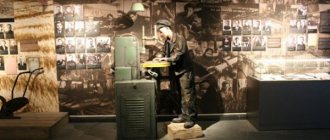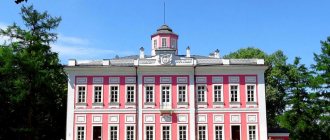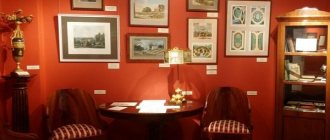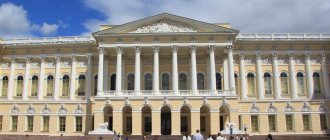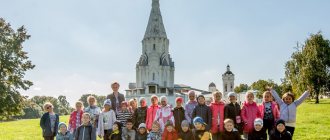Memorial House-Museum of S.P. Korolev (Moscow, Russia) - exhibitions, opening hours, address, phone numbers, official website.
- May tours
to Russia - Last minute tours
to Russia
Memorial House-Museum of S. P. Korolev
1/
10
The memorial house-museum of Academician S.P. Korolev, located in a quiet side street near the monument to the Conquerors of Space, is the place where the “father of Russian cosmonautics” lived the last 7 years of his life. It was here that the first manned flight into space was being prepared, within the walls of this house scientists celebrated the victory that opened a new era in the history of mankind, and from here on January 14, 1966 Korolev left for a surgical operation from which he was not destined to return. Today in the memorial house-museum everything looks exactly the same as during the life of Sergei Pavlovich: a cozy living room with books on the coffee table, a work table with notebooks and scientific literature, a small kitchen and an extensive library... A visit to the house will be an excellent addition to the exhibition of the Memorial Museum of Cosmonautics, especially Moreover, they are located within walking distance from each other.
A little history
The two-story stone mansion in a quiet park area was built specifically for Korolev as a sign of state recognition of his services in launching the first artificial Earth satellite in 1957. The house was built taking into account the wishes of the Korolev couple and turned out to be neat, functional and very cozy. The queens moved here in 1959 and lived until the death of the academician as a result of unsuccessful abdominal surgery in 1966. The widow Queen wished to perpetuate the memory of her husband by turning the mansion into a public house-museum, and almost completely formed its collections. All things here are left in their places, just as they were on the last day of the earthly life of the founder of astronautics. The museum opened its doors to visitors in 1975.
What to see
The exhibition and funds of the memorial house-museum number more than 19 thousand storage units. But the most interesting thing here, of course, is the original setting in which the life of the great man took place.
In front of the house you will see a granite monument to S.P. Korolev, moved here from the Alley of Cosmonauts in front of the monument to the Conquerors of Space. The entrance to the mansion is through the ground floor, so as not to disturb the safety of the hallway and dressing room, in which Korolev’s coat still hangs and Korolev’s shoes are kept.
Pay attention to the small copy of the sculpture “To the Stars”: the cosmonauts of the first detachment left their autographs on its pedestal.
In the living room there are numerous porcelain figurines, upholstered furniture under cozy covers, a table with magazines and newspapers dated January 14, 1966, a fireplace and a film projector, a radio, a TV and a piano. The tables are set in the dining room and kitchen and it seems that lunch is about to be ready. As you climb the stairs to the second floor, pay attention to the extensive library of not only scientific but also fiction literature. The desk in Korolev’s office is literally littered with piles of books, and here you can also see the future scientist’s student notes. A bedroom with a bathroom and a spacious veranda complete the exhibition.
House-Museum of S.P. Koroleva in Moscow
07/31/2019 Natalia Karetnikova Russia, Russia and CIS, Countries
Comments:
Visiting the Russian genius
Many quiet corners of Moscow keep their secrets for the time being. Old-timers of Ostankino remember how in the late 50s of the last 20th century, construction began not far from VDNKh, opposite the linden alley (there is now a shopping center there). Dilapidated residential buildings and warehouses were demolished, then a land plot of 0.8 hectares was fenced off from prying eyes. Later, on the cleared site, behind a new solid high green fence, a white stone two-story mansion appeared under the canopy of mighty oak trees. He was constantly guarded inside and outside by inconspicuous people in civilian clothes. Not a single living soul in the area knew who settled in this mysterious house. From time to time, its gates opened, quietly rustling tires, and respectable cars drove into the yard. The hosts were receiving guests these days. This is roughly how the story of this mystery house began, which gave its mysterious inhabitants six years of happy family life.
This mysterious house was a gift from the Soviet government to the founder of practical cosmonautics, academician Sergei Pavlovich Korolev. The scientific community of that country, which was then called the USSR, wanted to nominate a brilliant scientist for the Nobel Prize. But the party leadership of the CPSU, which then ruled our huge country, decided otherwise. Having deprived the most secret Chief Designer of the opportunity to become a Nobel Prize laureate, the party leadership of the USSR decided in 1958 to compensate for it by giving the brilliant scientist a dacha in Ostankino for the development and successful launch of the world's first artificial Earth satellite. The two-story mansion, surrounded by a garden, is located near the monument to the Conquerors of Space, in one of the Ostankino lanes.
Today anyone can visit his house. The whole atmosphere of the Korolev Memorial Museum helps to learn a lot about the unique scientist, not only professionally, but also as a person. Next to the museum building there is a monument to the academician, brought here from the Alley of Cosmonauts, on which a sculpture of Korolev was installed.
Everything that the museum has - from the neat notes of a young student at the Kyiv Polytechnic Institute of the 20s to a notebook telling about the affairs and concerns of the chief designer in the last month of his life - all this was transferred to state storage by Nina Ivanovna Koroleva.
Architecture and interior decoration of S.P.’s house Koroleva is a piece of the history and culture of everyday life in Russia in the mid-twentieth century.
Before the start of the excursion, everyone goes down to the lecture hall (cinema), which is located in a comfortable basement, where guests are shown a short film about the scientist.
Korolev visited Moscow on visits; he spent quite a lot of time at the cosmodrome and at missile ranges. Once upon a time, Sergei Pavlovich was the most protected academician of the USSR.
Almost no one knew what the man who designed space technology and who led the first flight into space looked like. Moreover, no one could know where he lived.
I visited there for the first time in January 2007 on the opening day of the Memorial House-Museum of Academician S.P. Queen after restoration. In that already distant January there was no snow yet. The mysterious house appeared before the guests with smooth paving stones in the yard, a beautiful lawn and a modern video surveillance system.
Guests were greeted at the entrance by the owner of the house - Academician S.P. Korolev in a sculptural image. The monument, moved to the house from the Alley of Cosmonauts, which is near the monument to the “Conquerors of Space,” fit into the museum ensemble so well, as if it had always stood here.
Among the guests of honor that day were: comrade S.P. Koroleva, academician B.E. Chertok; cosmonaut No. 4 from the legendary first detachment of Soviet cosmonauts P.R. Popovich; pilot-cosmonauts V.V. Gorbatko; IN AND. Sevastyanov; A.A. Serebrov; M. Kh. Manarov; V.V. Polyakov; A.N. Balandin, as well as important people from the Moscow government and representatives of space industries and science.
Muscovites also expressed their respect and admiration for the great man by laying fresh flowers at the foot of the monument to S.P. Queen. A huge screen was installed on the site near the house, where they showed photographs of its owner with family, friends and the first cosmonauts.
Before the tour of the renovated museum, I was able to have a very short conversation with USSR pilot-cosmonaut No. 4 Pavel Romanovich Popovich, a member of the first cosmonaut corps, twice a hero of the Soviet Union.
He was the pilot of the Vostok 4 spacecraft; commander of the Soyuz-14 spacecraft. His call sign was “Berkut”. I asked Pavel Romanovich about health and life. She told me how, when she was still a pioneer, she was worried about him when he was on space flights. He was so moved by my story that he hugged me and kissed me. Together we went on an excursion.
A unique museum of a great man
What is the uniqueness of this, not the most famous museum in Moscow? This mansion became a memorial house-museum in 1975, when the widow of academician N.I. Korolev transferred everything that the museum now has to state storage. She was the museum's chief consultant for 25 years. All the objects were placed here with her hands, right down to the very last chair. The uniqueness of the museum lies in its exhibition, which contains only authentic personal belongings of Academician Korolev.
These are letters, documents, photographs, clothing, household items, scientific, technical and art libraries, paintings and other works of art, original furniture and all the furnishings of his office, other rooms and premises of the house on two floors, right down to window curtains, carpets and dishes .
Here Korolev was happy and loved
Everything here is permeated with the warmth of two tenderly loving hearts. I imagined in what mood the pretty, slender housewife was carefully and carefully arranging her new home, trying to make it cozy and comfortable for her beloved husband Seryozha. And he joked: “We have a cult of Serezhenka in our house: “Seryozhenka doesn’t eat this, doesn’t eat that.” Walk more quietly: Seryozhenka is sleeping!” Yes, that's exactly what happened here.
He also loved the small kitchen where he had breakfast and dinner. There, his faithful housekeeper Manyasha was working her magic at the stove, preparing his favorite cabbage rolls and stuffed zucchini.
She was always at the same table with the owners, even despite the presence of distinguished guests.
The owner of the house liked to look into his wife’s small room in the evening, after a hard day at work. Sergei Pavlovich enjoyed a special favor in his office, where he spent hours, and sometimes sleepless nights, thinking about new space projects.
Sergei Pavlovich considered books to be the most valuable items in the house. There are many of them in his office. More than two hundred books only with autographs of the authors.
I often picked up one of the volumes of “War and Peace” by L.N. Tolstoy and reread his favorite chapters. He was fond of science fiction, especially loved Stanislav Lemm, Ray Bradbury, Alexander Belyaev. He was greatly impressed by Ivan Efremov’s book “The Andromeda Nebula.” He advised his family, friends and astronauts to read it. In the silence of S.P.’s office Korolev thoughtfully read academic journals and often looked through various periodicals, including the magazine Yunost.
In the mornings, he picked up the dumbbells that were still standing in the corner. He diligently did gymnastics: a set of exercises recommended by doctors. At this time no one bothered him.
Sometimes there were guests in the Korolevs’ house: friends of the owners, scientists, astronauts, writers, artists. On such a day, a huge table with treats was set.
It was fun, there was always music: Russian folk songs, ancient romances and modern lyrical songs from films. Spouse S.P. Koroleva, Nina Ivanovna, without a classical musical education, had good hearing and a pleasant voice. She played by notes, sometimes picking out the melodies she liked by ear.
Once, for his wife’s birthday, Sergei Pavlovich gave her a wonderful instrument, a brown piano from the famous Steinway company. He loved listening to her sing. The notes of L. Malyshkin’s romance “I Met You” based on F. Tyutchev’s poems lying on the piano remind us of this.
Not being great connoisseurs of classical music, the Korolevs often visited theaters and the conservatory. Nina Ivanovna and Sergei Pavlovich loved ballet very much.
Knowing this, the famous sculptor M. Manizer gave Sergei Pavlovich a figurine of his favorite ballerina Galina Ulanova in the image of the “Dying Swan”. You can still see it in the living room.
In the house there was a Dnepr tape recorder, rare at that time, and a large television of the best domestic brand at that time, Rubin.
The couple preferred to watch movies on TV. Occasionally a projectionist was invited to the house. He installed a home film projector and screen, showing a feature film ordered by the owners in advance. Usually it was a musical comedy or a good serious film. Of the domestic films, he really liked G. Nathanson’s film “Everything Remains to the People” with Nikolai Cherkasov in the title role. Korolev also loved the drama of the French director J. Duvivier “Marie-October” with the participation of Danielle Darrieu, Paul Meurice, Bernard Blier, Lino Ventura. A film about the heroes of the French Resistance during the Second World War.
There is also a beautiful, high-quality fireplace in the living room. But for as long as this house can remember, the owners have used this fireplace only once. One day, astronauts came to visit them. Yuri Gagarin persuaded Nina Ivanovna to allow him to light the fireplace. He spent a long time fiddling around by the fireplace. But nothing good came of this idea. Only the first cosmonaut of the Earth blew smoke throughout the house.
I had to open all the windows and even the large floor-length French window into the garden and ventilate the room. Since then the fireplace has not been used. No one else has taken such courage.
Most of the paintings in the house were purchased by the owners. There are gifts here from authors and friends. An interesting ebony figurine of a mother and baby was presented by Valentina Tereshkova after her trip to the island of Bali. On the ground floor of the house there is a beautiful bronze sculpture called “To the Stars” by G. Postnikov.
This is a gift from the first eleven cosmonauts to the Chief Designer with their autographs on the pedestal.
In addition to those already listed, the museum has many priceless exhibits that give us the opportunity to touch the pages of the life of our great compatriot, academician Sergei Pavlovich Korolev.
Having familiarized yourself with the exhibits and the spiritual life of the museum, you are imbued with the idea that in this home of his he was happy and loved.
The Queens showed special care and love for their small garden and flower beds near the house. Nina Ivanovna alone and with her assistants planted various fruit trees, beautifully blooming bushes and flowers. Sergei Pavlovich, too, when he was at home, loved to tinker with his wife in the garden.
He often walked along the well-groomed paths of the garden. Of all the flowers, he loved roses, carnations and wildflowers. All the trees and shrubs have been preserved in the garden since that ancient time. Beautiful alleys lead from the house to the garden. They were here even under his owners.
On the morning of January 5, 1966, Korolev went to the hospital. The doors of the house closed behind the owner forever. Heart of S.P. Korolev could not bear the difficult hours-long operation. His memory is immortalized both on Earth and in Space. Streets and squares of cities, one of the peaks of the Pamirs, the Tien Shan mountain pass, and a mountain range on the Moon are named after Korolev. The Moscow region city of Kaliningrad, where the Chief Space Designer worked for many years, was renamed in 1996 to Korolev.
The clock on the mantelpiece in the Ostankino mansion shows 16 hours 30 minutes. At this time, the heart of his owner, Sergei Pavlovich Korolev, stopped beating - a great man, the brilliant Chief Designer of the first spaceships, who remained for us and the entire sublunary world a legend, an unsolved mystery of the 20th century, which is kept behind a green fence by his Ostankino Memorial House-Museum .
I was lucky: in memory of my first visit to the house-museum of S.P. Korolev gave me an exclusive book, “Tender Letters from a Severe Man,” published in a small edition.
The first copies of the book were presented to space heroes. This book is special: it contains letters, telegrams, and notes from S.P. for the first time. Korolev to his wife Nina Ivanovna, as well as her memories of her husband. Together they lived the last 19 years of his life. On the pages of the book, the events of past years come to life, hitherto unknown new facets of the image of the great man are revealed.
***
Museum address: Moscow, 1st Ostankino street, building 28 The museum is open from Wednesday to Sunday from 11 to 19 hours. The last Friday of the month is sanitary day. Entrance ticket without excursion - 100 rubles, for preferential categories - 50 rubles. For war veterans and disabled people of groups I and II, admission is free.
Tours by session: at 11, 12, 13, 14, 15 and 16 hours. The excursion costs 750 rubles (payment in cash only). Shooting with a camera costs 230 rubles, while shooting with a phone or tablet is free.
Phone for information:
If you liked this article, share it with your friends and on social networks: the “Share” buttons are located below
Related notes:
All materials by the same author
share link:
Add a comment Cancel reply
- Irina Fedorchenko
03.07.201917:20
There are so many museums in Moscow. It sounds strange to replace the Nobel Prize with a two-story house. A sad fate and absurd death for such a talented person... Thanks for the article, otherwise he will soon be completely forgotten.
Answer
- Karetnikova Natalia
04.07.201908:40
Thank you for your feedback, Irochka! If we recall the brilliant quote that has gone to the people, from a poem by Alexander Kushner: You don’t choose times, They live and die in them. Much becomes clear. Korolev is our great contemporary, and you and I remember that time very well. What “great” personalities were in power. What could you expect from them then? We would have flown to the Moon and beyond long ago if we had not ruined our geniuses and slowed down the development of space technology. How many interesting projects were rejected! But the USSR only needed missiles to “catch up and overtake America”! Only Korolev was allowed to build a two-story modest house in Moscow. Other designers and developers (one of them was Boris Chertok) were given building plots already in the region. Of course, this is not even a bird in the hand... But such was the time.
Answer
Tags:
- House Museum of Sergei Korolev
- Korolev House-Museum
- Interesting museums in Moscow
- Interesting museum
- Moscow
- Museum
- Russia
